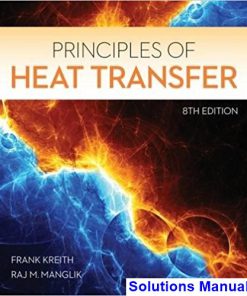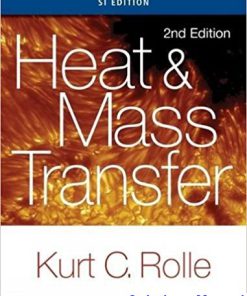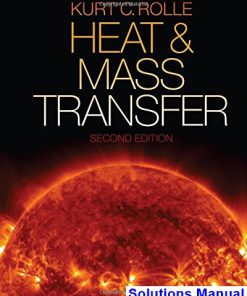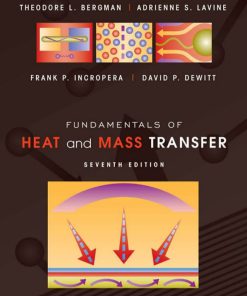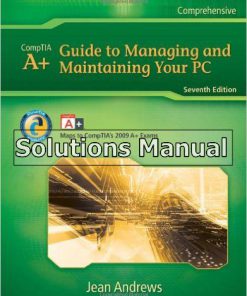Radiative Heat Transfer 3rd Edition Modest Solutions Manual
$50.00 Original price was: $50.00.$26.50Current price is: $26.50.
Radiative Heat Transfer 3rd Edition Modest Solutions Manual.
This is completed downloadable of Radiative Heat Transfer 3rd Edition Modest Solutions Manual
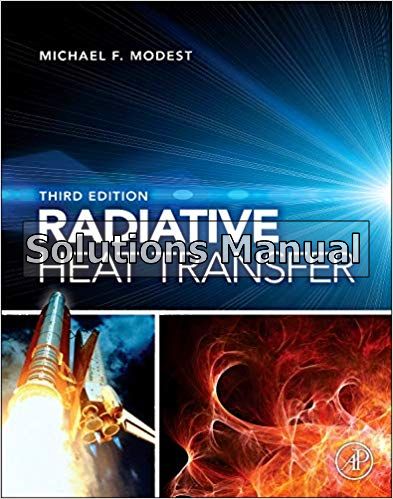
Product Details:
- ISBN-10 : 0123869447
- ISBN-13 : 978-0123869449
- Author: Michael F. Modest
The third edition of Radiative Heat Transfer describes the basic physics of radiation heat transfer. The book provides models, methodologies, and calculations essential in solving research problems in a variety of industries, including solar and nuclear energy, nanotechnology, biomedical, and environmental.
Every chapter of Radiative Heat Transfer offers uncluttered nomenclature, numerous worked examples, and a large number of problems―many based on real world situations―making it ideal for classroom use as well as for self-study. The book’s 24 chapters cover the four major areas in the field: surface properties; surface transport; properties of participating media; and transfer through participating media. Within each chapter, all analytical methods are developed in substantial detail, and a number of examples show how the developed relations may be applied to practical problems.
Table of Content:
Chapter 1. Fundamentals of Thermal Radiation
1.1 Introduction
1.2 The Nature of Thermal Radiation
1.3 Basic Laws of Thermal Radiation
1.4 Emissive Power
1.5 Solid Angles
1.6 Radiative Intensity
1.7 Radiative Heat Flux
1.8 Radiation Pressure
1.9 Visible Radiation (Luminance)
1.10 Radiative Intensity In Vacuum
1.11 Introduction to Radiation Characteristics of Opaque Surfaces
1.12 Introduction to Radiation Characteristics of Gases
1.13 Introduction to Radiation Characteristics of Solids and Liquids
1.14 Introduction to Radiation Characteristics of Particles
1.15 The Radiative Transfer Equation
1.16 Outline of Radiative Transport Theory
References
Problems
Chapter 2. Radiative Property Predictions From Electromagnetic Wave Theory
2.1 Introduction
2.2 The Macroscopic Maxwell Equations
2.3 Electromagnetic Wave Propagation In Unbounded Media
2.4 Polarization
2.5 Reflection And Transmission
2.6 Theories For Optical Constants
References
Problems
Chapter 3. Radiative Properties of Real Surfaces
3.1 Introduction
3.2 Definitions
3.3 Predictions From Electromagnetic Wave Theory
3.4 Radiative Properties Of Metals
3.5 Radiative Properties Of Nonconductors
3.6 Effects Of Surface Roughness
3.7 Effects Of Surface Damage And Oxide Films
3.8 Radiative Properties Of Semitransparent Sheets
3.9 Special Surfaces
3.10 Experimental Methods
Reflection Measurements
References
Problems
Chapter 4. View Factors
4.1 Introduction
4.2 Definition Of View Factors
4.3 Methods For The Evaluation Of View Factors
4.4 Area Integration
4.5 Contour Integration
4.6 View Factor Algebra
4.7 The Crossed-Strings Method
4.8 The Inside Sphere Method
4.9 The Unit Sphere Method
References
Problems
Chapter 5. Radiative Exchange Between Gray, Diffuse Surfaces
5.1 Introduction
5.2 Radiative Exchange Between Black Surfaces
5.3 Radiative Exchange Between Gray, Diffuse Surfaces
5.4 Electrical Network Analogy
5.5 Radiation Shields
5.6 Solution Methods For The Governing Integral Equations
References
Problems
Chapter 6. Radiative Exchange Between Partially Specular Gray Surfaces
6.1 Introduction
6.2 Specular View Factors
6.3 Enclosures With Partially Specular Surfaces
6.4 Electrical Network Analogy
6.5 Radiation Shields
6.6 Semitransparent Sheets (Windows)
6.7 Solution Of The Governing Integral Equation
References
Problems
Chapter 7. Radiative Exchange Between Nonideal Surfaces
7.1 Introduction
7.2 Radiative Exchange Between Nongray Surfaces
7.3 Directionally Nonideal Surfaces
7.4 Analysis For Arbitrary Surface Characteristics
References
Problems
Chapter 8. The Monte Carlo Method for Surface Exchange
8.1 Introduction
8.2 Numerical Quadrature By Monte Carlo
8.3 Heat Transfer Relations For Radiative Exchange Between Surfaces
8.4 Random Number Relations For Surface Exchange
8.5 Surface Description
8.6 Ray Tracing
8.7 Efficiency Considerations
References
Problems
Chapter 9. Surface Radiative Exchange in the Presence of Conduction and Convection
9.1 Introduction
9.2 Conduction and Surface Radiation—Fins
9.3 Convection and Surface Radiation
References
Problems
Chapter 10. The Radiative Transfer Equation in Participating Media (RTE)
10.1 Introduction
10.2 Attenuation By Absorption And Scattering
10.3 Augmentation By Emission And Scattering
10.4 The Radiative Transfer Equation
10.5 Formal Solution To The Radiative Transfer Equation
10.6 Boundary Conditions For The Radiative Transfer Equation
10.7 Radiation Energy Density
10.8 Radiative Heat Flux
10.9 Divergence Of The Radiative Heat Flux
10.10 Integral Formulation Of The Radiative Transfer Equation
10.11 Overall Energy Conservation
10.12 Solution Methods For The Radiative Transfer Equation
References
Problems
Chapter 11. Radiative Properties of Molecular Gases
11.1 Fundamental Principles
11.2 Emission and Absorption Probabilities
11.3 Atomic and Molecular Spectra
11.4 Line Radiation
11.5 Nonequilibrium Radiation
11.6 High-Resolution Spectroscopic Databases
11.7 Spectral Models for Radiative Transfer Calculations
11.8 Narrow Band Models
11.9 Narrow Band k-Distributions
11.10 Wide Band Models
11.11 Total Emissivity and Mean Absorption Coefficient
11.12 Experimental Methods
References
Problems
Chapter 12. Radiative Properties of Particulate Media
12.1 Introduction
12.2 Absorption and Scattering From A Single Sphere
12.3 Radiative Properties of A Particle Cloud
12.4 Radiative Properties of Small Spheres (Rayleigh Scattering)
12.5 Rayleigh-Gans Scattering
12.6 Anomalous Diffraction
12.7 Radiative Properties of Large Spheres
12.8 Absorption and Scattering By Long Cylinders
12.9 Approximate Scattering Phase Functions
12.10 Radiative Properties of Irregular Particles and Aggregates
12.11 Radiative Properties of Combustion Particles
12.12 Experimental Determination of Radiative Properties of Particles
References
Problems
Chapter 13. Radiative Properties of Semitransparent Media
13.1 Introduction
13.2 Absorption by Semitransparent Solids
13.3 Absorption by Semitransparent Liquids
13.4 Radiative Properties of Porous Solids
13.5 Experimental Methods
References
Problems
Chapter 14. Exact Solutions for One-Dimensional Gray Media
14.1 Introduction
14.2 General Formulation for A Plane-Parallel Medium
14.3 Plane Layer of A Nonscattering Medium
14.4 Plane Layer of A Scattering Medium
14.5 Radiative Transfer in Spherical Media
14.6 Radiative Transfer in Cylindrical Media
14.7 Numerical Solution of the Governing Integral Equations
References
Problems
Chapter 15. Approximate Solution Methods for One-Dimensional Media
15.1 The Optically Thin Approximation
15.2 The Optically Thick Approximation (Diffusion Approximation)
15.3 The Schuster–Schwarzschild Approximation
15.4 The Milne–Eddington Approximation (Moment Method)
15.5 The Exponential Kernel Approximation
References
Problems
Chapter 16. The Method of Spherical Harmonics (PN-Approximation)
16.1 Introduction
16.2 General Formulation of the PN-Approximation
16.3 The PN-Approximation for a One-Dimensional Slab
16.4 Boundary Conditions for the PN-Method
16.5 The P1-Approximation
16.6 P3- and Higher-Order Approximations
16.7 Simplified PN-Approximation
16.8 The Modified Differential Approximation
16.9 Comparison of Methods
References
Problems
Chapter 17. The Method of Discrete Ordinates (SN-Approximation)
17.1 Introduction
17.2 General Relations
17.3 The One-Dimensional Slab
17.4 One-Dimensional Concentric Spheres and Cylinders
17.5 Multidimensional Problems
17.6 The Finite Volume Method
17.7 The Modified Discrete Ordinates Method
17.8 Even-Parity Formulation
17.9 Other Related Methods
17.10 Concluding Remarks
References
Problems
Chapter 18. The Zonal Method
18.1 Introduction
18.2 Surface Exchange — No Participating Medium
18.3 Radiative Exchange in Gray Absorbing/Emitting Media
18.4 Radiative Exchange in Gray Media with Isotropic Scattering
18.5 Radiative Exchange Through A Nongray Medium
18.6 Determination of Direct Exchange Areas
References
Problems
Chapter 19. Collimated Irradiation and Transient Phenomena
19.1 Introduction
19.2 Reduction of the Problem
19.3 The Modified P1-Approximation with Collimated Irradiation
19.4 Short-Pulsed Collimated Irradiation with Transient Effects
References
Problems
Chapter 20. Solution Methods for Nongray Extinction Coefficients
20.1 Introduction
20.2 The Mean Beam Length Method
20.3 Semigray Approximations
20.4 The Stepwise-Gray Model (Box Model)
20.5 General Band Model Formulation
20.6 The Weighted-Sum-of-gray-Gases (WSGG) Model
20.7 k-Distribution Models
20.8 The Full Spectrum k-Distribution (FSK) Method for Homogeneous Media
20.9 The Spectral-Line-Based Weighted Sum of Gray Gases (SLW)
20.10 The FSK Method for Nonhomogeneous Media
20.11 Evaluation of k-Distributions
References
Problems
Chapter 21. The Monte Carlo Method for Participating Media
21.1 Introduction
21.2 Heat Transfer Relations for Participating Media
21.3 Random Number Relations for Participating Media
21.4 Treatment of Spectral Line Structure Effects
21.5 Overall Energy Conservation
21.6 Discrete Particle Fields
21.7 Efficiency Considerations
21.8 Backward Monte Carlo
21.9 Direct Exchange Monte Carlo
21.10 Example Problems
References
Problems
Chapter 22. Radiation Combined with Conduction and Convection
22.1 Introduction
22.2 Combined Radiation and Conduction
P1-Approximation
Additive Solutions
Other Work
22.3 Melting and Solidification with Internal Radiation
22.4 Combined Radiation and Convection in Boundary Layers
22.5 Combined Radiation and Free Convection
22.6 Combined Radiation and Convection in Internal Flow
22.7 Combined Radiation and Combustion
22.8 Interfacing Between Turbulent Flow Fields and Radiation
22.9 Interaction of Radiation with Turbulence
22.10 Radiation in Concentrating Solar Energy Systems
References
Problems
Chapter 23. Inverse Radiative Heat Transfer
23.1 Introduction
23.2 Solution Methods
23.3 Regularization
23.4 Gradient-Based Optimization
23.5 Metaheuristics
23.6 Summary of Inverse Radiation Research
References
Problems
Chapter 24. Nanoscale Radiative Transfer
24.1 Introduction
24.2 Coherence of Light
24.3 Evanescent Waves
24.4 Radiation Tunneling
24.5 Surface Waves (Polaritons)
24.6 Fluctuational Electrodynamics
24.7 Heat Transfer Between Parallel Plates
24.8 Experiments on Nanoscale Radiation
References
Problems
Appendix A. Constants and Conversion Factors
Appendix B. Tables for Radiative Properties of Opaque Surfaces
Appendix C. Blackbody Emissive Power Table
Appendix D. View Factor Catalogue
References
Appendix E. Exponential Integral Functions
Appendix F. Computer Codes
References
Acknowledgments
Index
People Also Search:
radiative heat transfer modest
radiative heat transfer 3rd edition modest
radiative heat transfer
radiative heat transfer 3rd edition
radiative heat transfer 3rd edition download scribd
radiative heat transfer 3rd edition solution manual download pdf
modest radiative heat transfer 3rd edition
Instant download after Payment is complete
You may also like…
Engineering
Separation Process Engineering Includes Mass Transfer Analysis 4th Edition Wankat Solutions Manual
Solutions Manual
Separation Process Engineering Includes Mass Transfer Analysis 3rd Edition Wankat Solutions Manual
Related products
Solutions Manual
Solutions Manual
Accounting Texts and Cases 13th Edition Anthony Solutions Manual
Solutions Manual
Solutions Manual
Accounting Volume 2 Canadian 8th Edition Horngren Solutions Manual
Solutions Manual
A+ Guide to IT Technical Support Hardware and Software 9th Edition Andrews Solutions Manual





